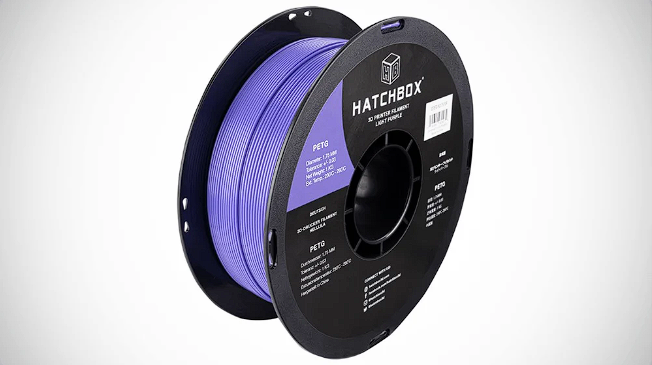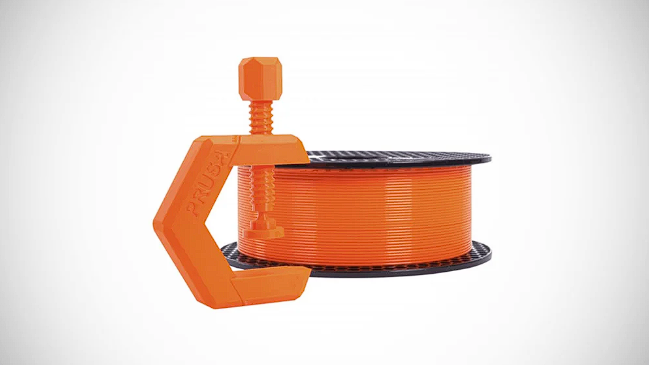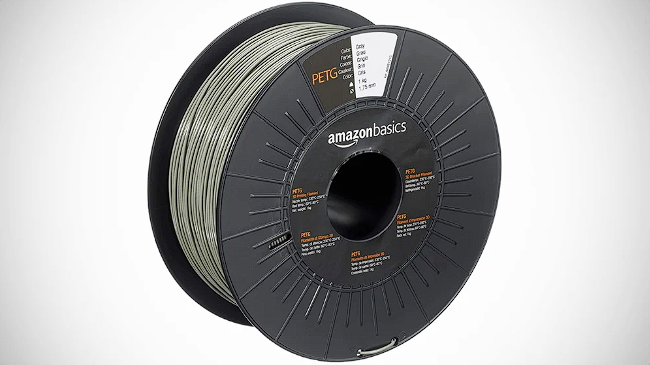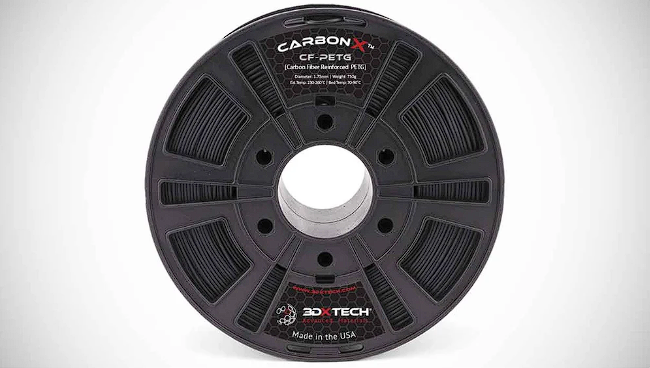Find the best PETG filament for your needs and budget. Get an overview of the best brands available on the market right now.
What Is PETG? – Simply Explained
PETG has taken the main stage for 3D printing materials in recent years. As an easy-to-print, food-safe, durable, and affordable material, it’s largely displaced ABS as the second most popular filament — next to PLA.
Because of its high strength, impact resistance, and temperature resistance compared to PLA, PETG is often used for practical applications that need to accommodate regular use and a bit of flexibility.
You’ll need to choose a supplier whose product you trust to be easy to work with and reliable. We’ve written this article to help you narrow down your filament selection to a curated list of the best PETG brands right now so you can make a better-informed decision. We judged inclusions in our list on price, variety of colors, and quality.
Read on and get printing!
Eryone PETG

At All3DP, we can’t claim to have extensive experience with all the most popular filament brands (yet), but Eryone is one of the materials we often keep on hand — for that reason, it’s featured as our Editor’s Pick.
3D Printing with PETG: The 5 Best Tips
Eryone PETG is a good filament with a mid-range dimensional tolerance of ±0.03mm and only a marginal price increase, totaling ~$23, for a 1 kg spool for the increased quality. One catch, it is the most limited in variety listed here, with only eight colors to choose from, but if that’s not of concern, it’s a great choice.
Buy For: Higher-than-average dimensional accuracy at a reasonable price.
MatterHackers Build PETG

MatterHackers have been selling filament for a long time now and have become a household name for makers. Its Build Series is the company’s consumer filament line, made to balance cost and quality.
MatterHackers Build Series PETG is certainly a good material for the low price, with a dimensional accuracy of ±0.05 mm for a retail price of ~$20 for 1 kg spools. It’s a reasonably strong material suitable for standard use that comes in 12 colors.
Buy For: An affordable, good quality material from a reputable company.
MatterHackers Pro PETG

MatterHackers don’t just sell to consumers; the company also diversifies its portfolio with the professionally-aimed Pro Series, which aims to deliver the most consistent dimensional accuracy they can.
At ±0.02 mm, Matterhackers’ Pro Series PETG is a highly consistent product in 13 colors. The company bills the material as “exceptionally tough and sturdy,” offering high durability prints. It is pricey, though. A 1 kg spool of MH Pro Series PETG will run you $55 (with free shipping in the USA).
Buy For: Extra toughness with high dimensional accuracy for professional use.
Polymaker PolyLite PETG

Polymaker is another reputable 3D printing material manufacturer with lots of product lines for different specializations, but we’re looking at PolyLite, its general consumer material that covers the most popular varieties of 3D printing filament.
The material has a standard tolerance of ±0.05 mm and is priced at ~$23 for a 1 kg spool. The packaging is also fairly nice, with lines on the label that tell you approximately how much material you have left on a spool. Good for knowing when you need to order more.
Buy For: A standard material from a reputable brand, or if you like spools that mark material levels.
Polymaker PolyMax PETG
Polymaker positions PolyMax as their high-quality product line, using “nano-reinforcement technology” to make a superior product. The claim: PolyMax PETG, like other materials in the category, has “exceptional mechanical properties and printing quality.”
The company doesn’t seem to be targeting professional applications with PolyMax materials necessarily and has an average tolerance of ±0.05mm. Rather, it seems to market the filament as a generally superior variety of consumer material. For that, customers are asked to pay ~$33 for 750 grams of filament available in just two colors.
Buy For: Specific applications — if you need a high-quality version of familiar material and don’t mind the average dimensional accuracy.
Hatchbox PETG

A popular materials company, Hatchbox gets a lot right with its PETG filament.
It keeps tolerances tight with a dimensional accuracy of ±0.03 mm, the price is right at ~$24 for a 1 kg spool, and there’s an incredible variety of 25 colors to choose from — which launches Hatchbox PETG into our top picks for Value Pick. If you like having plenty of pretty options from your materials, this is the way to go.
Buy For: Good tolerances with exceptional color variety.
Prusament PETG

The darling of the 3D printing community, Prusa Research, also has its own line of 3D printing materials. Like all of the company’s products, its PETG filament is produced to exacting specifications.
Because Prusa Research’s PETG filament has an exceptional dimensional accuracy of ±0.02 mm for a reasonable price of ~$30 per 1 kg spool, it’s earned its place as our all-around Top Pick. It also has an enviable variety, with 18 colors available to choose from.
Since Prusa Research is well known for its excellent support, we’re confident it translates to materials.
Buy For: High dimensional accuracy for a reasonable price from a highly reputable company.
AmazonBasics PETG

Amazon offers its own brand of 3D printing filaments under the AmazonBasics label. If you’re in a rush and happen to be an Amazon Prime member, the online behemoth’s material might be a good choice since, as its own product, it will always boast speedy Prime shipping. And, if you don’t like it, it’s covered by Amazon’s relaxed return policy and backed by a one-year limited warranty.
Unfortunately, Amazon doesn’t list the material’s dimensional tolerance in the description, so we can’t be sure where those levels are. However, it comes in a reasonable variety of ten colors, all in 1 kg spools.
AmazonBasics filament used to have the most tempting price on the market, but now, at ~$20, more frugally-dedicated brands offer materials in greater variety and more transparency regarding details like tolerance.
Buy For: Fast and easy shipping at a low price.
PET VARIANTS
Though PETG is perhaps the best known in its family of filaments, as far as 3D printing enthusiasts are concerned, it’s actually a variant of PET plastic: polyethylene terephthalate, an exceedingly common material often found in water bottles and other single-use plastics.
There are more variations of PET in filament than just the familiar glycol-added version, and all of them share many properties — but with some important differences. The below provides an overview of PET-variants also available as 3D printer filaments with similar properties. Want something recyclable? Wish PETG had some properties just a little different? Check this list out and find the right filament for the job you have in mind.
PET

Polyethylene terephthalate (PET) is the most commonly used plastic in the world. It’s the unmodified parent of PETG, and it’s in everything, from your water bottle to clothing fibers and even in your food containers. But, it’s not an especially common filament.
Special property: Food safe and melts at higher temperatures of at least 260 °C. It may be curbside recyclable in your community, but check whether unlabeled plastics are accepted.
rPET

rPET is exactly the same as its base material, but this filament gets a lowercase “r” in its name because it is made of recycled PET. The distinction is important because materials can only be recycled a certain amount of time before they reach the end of their lifecycle. While printing, rPET will still behave like PET — making it an excellent material choice where unlabeled recycling (like 3D prints) isn’t possible.
Special property: Environmentally friendly.
CPE

Though a less common practice, some brands will choose to differentiate their PET products by using a moniker. Fillamentum and Ultimaker specifically use “CPE” because it stands for copolyester. It’s just a different name, so it should act exactly like any other PET unless you’ve gotten your hands on an unusual blend.
Special property: Tough, strong, more flexible, less odorous
PETT

PETT, or Polyethylene coTrimethylene Terephthalate, as you can probably tell, is another variant of PET. It’s slightly more rigid than PETG because it isn’t modified with glycol, so if you need that extra strength, it could be worth considering. PETT isn’t very common in 3D printing but was popularized by Taulman T-Glase for its impressive clarity after printing. Like PET and PETG, it’s usually food-safe (but still check).
Special property: It’s more rigid than PETG, beautifully clear, food-safe, and offers low shrinkage.
Composite / Reinforced PETG (Carbon Fiber, Glass, and more)

If PETG isn’t quite strong enough for your purpose, consider using a composite variant. Composite PETG, and other base material, is simply filled with small strands of another material to reinforce it. These strands are incredibly short, usually less than one millimeter, and serve to lend some of their properties to the base material.
Both glass and carbon fiber reinforced filament are common composites you can find with a base PETG material that increase material strength by a great deal, but check their individual properties to see which is best for your needs. Make sure you have a hardened steel or ruby nozzle and that your system is otherwise compatible with these abrasive filaments.
Special property: Very high tensile strength, other properties depending on the fiber used.